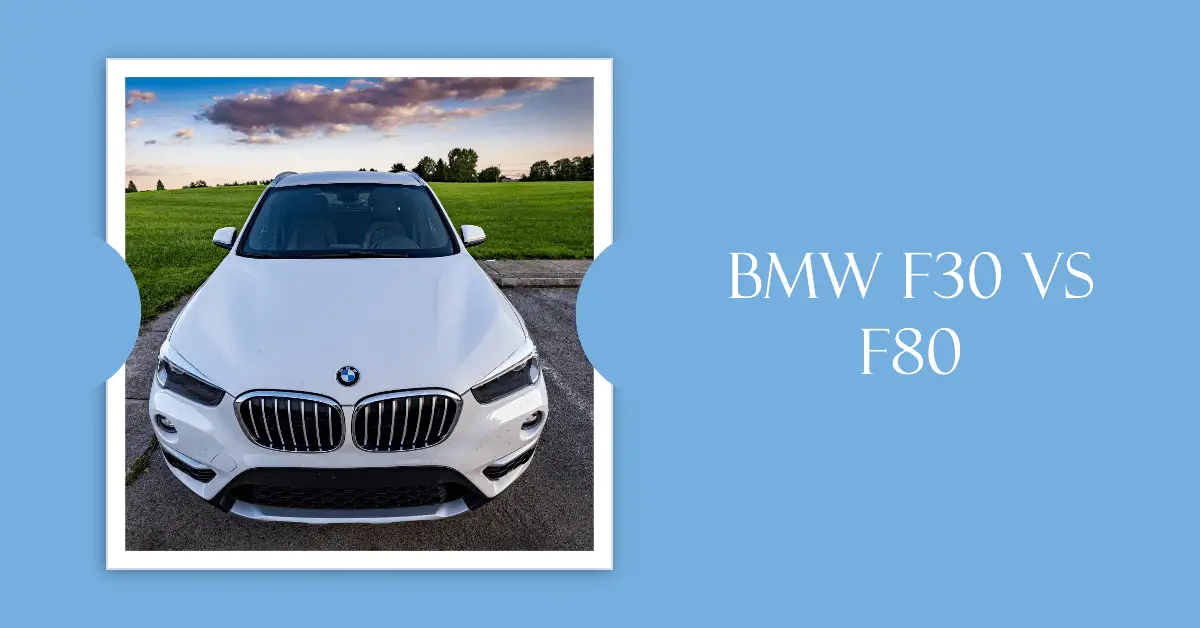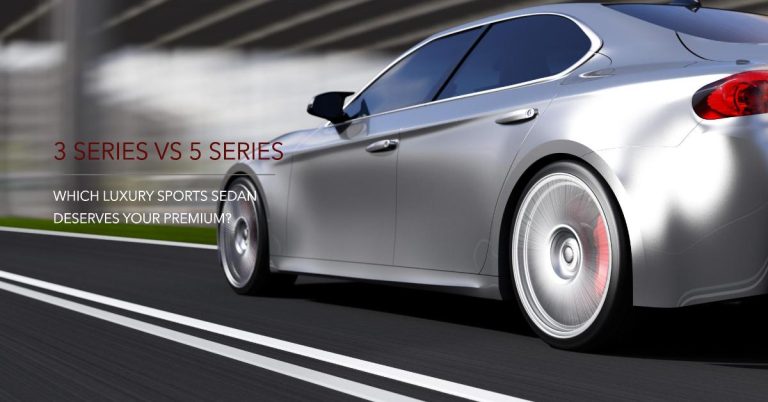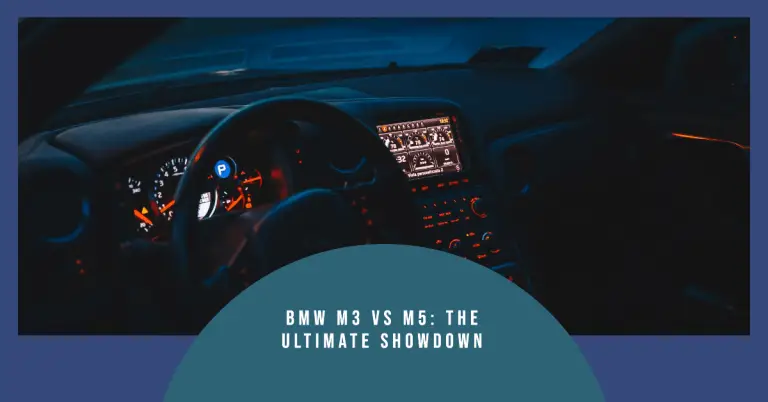F30 vs F80: Which BMW 3 Series is Right for You?
If you’re shopping for a luxury sport sedan from BMW, two of the brand’s most popular options are the 3 Series and 5 Series. The latest generations of these model lines, the F30 3 Series and F80 5 Series, offer refined performance, elegant interiors, and the latest technology. But should you opt for the smaller, more affordable 3 Series or splurge on the larger 5 Series?
This comprehensive comparison will examine the key differences between the BMW 3 Series F30 and BMW 5 Series F80 across all the factors that matter most, including pricing, performance, size, features, driving dynamics, fuel economy, and safety. After reviewing the pros and cons of each car, you’ll have all the details you need to decide if the F30 or F80 better fits your needs and budget.
Pricing – F30 More Affordable Overall
The BMW 3 Series carries a lower base price than the 5 Series, and generally costs less to buy used as well. The F30 340i starts at an MSRP of $45,800, while the F80 540i has a base price of $58,900. Even when similarly equipped, the F30 maintains a pricing advantage of $5,000 to $10,000 over the F80.
On the used market, F30 models have lower resale values and depreciate faster than the more premium F80. For example, a 2017 340i can be found for around $28,000 depending on the mileage and condition. A 2017 540i with similar miles sells for closer to $38,000. This significant difference in depreciation makes the 3 Series more affordable to own long term.
Maintenance and repairs will also cost less on the F30 compared to the F80. Items like brakes, tires, batteries, and fluids can be purchased at lower prices for the 3 Series. The F30 uses a smaller engine than the F80 as well, so over the life of the vehicle the F30 will cost less for fuel, oil changes, and tune-ups. Unless you really need the extra interior room and luxury features of the 5 Series, the 3 Series represents a much more affordable luxury sedan.
Performance – F80 Edges Out F30
When it comes to pure performance, the larger BMW 5 Series F80 beats the 3 Series F30 by a narrow margin, especially when comparing six-cylinder models. The F80 540i is powered by a 3.0L TwinPower turbo I6 producing 335 horsepower and 332 lb-ft of torque. It accelerates from 0-60 mph in just 4.6 seconds.
The F30 340i features a 3.0L TwinPower turbo inline-6 generating 320 horsepower and 330 lb-ft of torque. While still potent, it is slightly behind the F80 with a 0-60 mph time of 4.8 seconds. Both cars come standard with an eight-speed automatic transmission and rear-wheel drive, with xDrive all-wheel drive optionally available.
If you opt for the V8-powered 550i, the performance advantage of the 5 Series grows even larger. Its 4.4L twin-turbo V8 churns out 456 hp and 480 lb-ft, for a 0-60 mph sprint of just 4.3 seconds. The F30 tops out at 155 mph, while the 550i can reach up to 130 mph.
So while the F30 3 Series is impressively quick in its own right, buyers who want maximum acceleration and power should lean towards the BMW 5 Series F80.
Size and Practicality – F30 Easier to Drive and Park
The BMW 3 Series F30 is noticeably more compact and maneuverable than the larger 5 Series F80. Here is how the exterior dimensions compare:
- Length: 182.8 in (F30) vs 194.6 in (F80)
- Width: 71.3 in (F30) vs 74.9 in (F80)
- Wheelbase: 110.6 in (F30) vs 117.1 in (F80)
This smaller overall footprint makes the F30 simpler to drive and park, especially in tight city spaces. The turning radius is two feet tighter on the 3 Series at 17.2 feet, compared to 19 feet on the 5 Series. While the F80 isn’t as massive as a full-size luxury flagship, its extra size requires more attention and skill in parking garages and congested areas.
Inside the cabin, the F30 also has less passenger and cargo room. Front legroom measures 42 inches on both cars, but the F80 enjoys a significant advantage of 36.5 inches of rear legroom versus the F30’s 35 inches. The F80 likewise has more headroom front and rear to better accommodate taller passengers.
For hauling luggage and gear, the F80 offers 18.5 cubic feet of trunk space versus just 17 cubic feet on the F30. The rear seat also folds in a 40/20/40 split to create more cargo capacity when needed. Families or drivers who regularly transport clients will appreciate the F80’s roomier second row and trunk.
Features and Options – F80 Offers More Luxury
As BMW’s mid-size luxury sedan, the 5 Series F80 comes standard with more upscale features and options compared to the compact 3 Series F30. On the infotainment front, both cars come with the excellent iDrive system controlled via a 10.2-inch touchscreen. But the F80 gets navigation standard, while it remains an extra-cost option on the F30.
Other standard equipment on the F80 includes leather upholstery, a power moonroof, power trunk, and ambient interior lighting. The range of available luxury options is wider as well, such as ventilated front seats, a heated steering wheel, 2-axle air suspension, and premium audio systems.
For advanced driver assistance tech, the F80 gets more standard safety gear like blind spot monitoring, rear cross traffic alert, lane departure warning, and frontal collision warning. Overall, the larger 5 Series provides a more luxurious, high-tech driving experience in both front and rear seats.
Driving Dynamics – F30 More Agile and Engaging
The BMW 3 Series has always been renowned for its sports sedan handling capabilities, and the F30 continues that tradition with agile, responsive driving dynamics. Its smaller size along with suspension and steering tuning result in easier maneuverability and a more engaging time behind the wheel.
Equipped with the Adaptive M suspension, the F30 delivers relentlessly flat cornering and superior grip. Electric power steering provides outstanding road feel and quick reflexes. The chassis is incredibly balanced with 50/50 weight distribution front to rear. Simply put, the F30 just begs to be pushed hard through twisty back roads and sweepers.
While still athletic for its size class, the heavier F80 feels slightly softer and less nimble. Body roll is more pronounced, and the steering isn’t quite as sharp. The F80 prioritizes cruising refinement over all-out corner carving ability. For the purest driving experience, the BMW 3 Series remains the standard by which other sport sedans are measured.
Fuel Economy – F30 More Efficient
The F30 3 Series’ smaller, turbocharged engine helps it beat the F80’s fuel economy across the board. Here is how they compare based on EPA estimates:
City/Highway/Combined MPG
- F30 340i: 22/34/26
- F80 540i: 20/29/23
With maximum combined ratings of 26 mpg vs. 23, the F30 has a clear efficiency advantage in daily driving. On the highway, the gap widens further to 34 mpg for the 340i and just 29 mpg for the 540i. Over 15,000 miles of annual driving, that’s a difference of nearly 100 gallons of fuel per year.
Driving range is an important consideration as well. With a 15.8-gallon tank, the 340i can drive up to 537 miles between fill ups based on its highway fuel economy. The 540i has a larger 18.5-gallon tank, but still only achieves an estimated 537 miles before you’ll need to top up the tank again. For less frequent stops at the pump, the 3 Series is the easy pick.
Safety – Both Excellent
Fortunately, neither BMW scrimps on essential safety features and occupant protection. Both achieve perfect 5-Star overall ratings in NHTSA crash testing, with similar category scores:
- Frontal Crash: 5 stars F30 and F80
- Side Crash: 5 stars F30, 5 stars F80
- Rollover: 4 stars F30, 4 stars F80
The IIHS also awards its highest honor of “Top Safety Pick+” to both the F30 and F80. Sophisticated construction with crumple zones, side intrusion beams, and robust A and B pillars combine to form an incredibly strong passenger cell.
You also get plenty of active preventative safety tech on both cars. LED headlights and automatic high beams help illuminate the road ahead. Blind spot monitoring, rear cross traffic alert, lane departure warning, and frontal collision warning all come standard on the F80 and are optional on the F30. Overall visibility is excellent, aided by standard parking sensors and available surround view cameras. Simply put, both BMWs deliver reassuring levels of protection.
Conclusion: F30 3 Series Delivers the Best Balance
The BMW 5 Series F80 certainly tempts with its poised highway manners, lavish interior, and serious performance. But the F30 3 Series gets you surprisingly close to the F80 experience for substantially less money. Unless you absolutely require the larger back seat and cargo area offered by the 5 Series, the brilliant driving dynamics, upscale cabin, and strong acceleration of the F30 make it the smarter choice overall.
For shoppers focused on value, the F30 3 Series stands out as the best blend of practicality, luxury, and BMW performance in a nicely sized four-door package. It remains the benchmark sport sedan in its class that others strive to match, continuing the 3 Series’ decades-long legacy of delighting driving enthusiasts.







